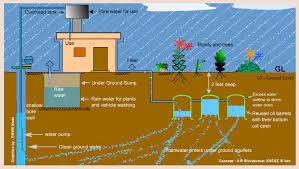
In my lamp lit village in Bajaal, on the banks of the River Netravathi, we worship the Goddess of rain and clouds, Dhoomavathi. There is a 3 day festival in April to celebrate her in the New Year. Rain is Nature’s way of recycling and purifying water
“A drop of water may spend 2 to 3 years in a river, 100 years in a glacier between a few weeks and thousands of years in a lake. Some rains will evaporate off the ground at once. Some will soak into the ground, where it will be absorbed by the roots of the plants and then returned to the air through their leaves. And some may sink deep into the ground to form ground water, where it may stay for thousands of years. It is always the same water that goes around in this cycle. Some of the water you shower in today may have flowed down the Amazon a year ago or may have washed the feet of an Egyptian Pharaoh 3000 years ago” writes Ed John Jamieson. Rain dances in Africa, with the sound of kettle drums are believed to bring down rain. Rain is the purest and most natural source of water. It recharges ground water so that underground aquifers, lakes, ponds, temple tanks and other water bodies can store water for the dry months. However, most of the rain water runs off into drains; the water gets evaporated in the sun. As a result many places suffer unnecessarily due to lack of water.
But, you only can receive as much as you give. The Rotarian code is that we give much more than we receive. This is true about rain water harvesting. One cannot go on sinking bore wells without paying attention to rain water harvesting and recharging of ground water. Those who forget this are destined to have their drinking water turn saline.
Rain water harvesting is an ideal process of collecting and storing water rather than allowing it to run into the sea or drains. Rainwater harvesting provides an independent water supply during drought. It is often used to supplement the main supply. It also helps mitigate flooding of low-lying areas, and reduces demand on wells which may enable ground water levels to be sustained. It also helps in the availability of potable water as rainwater is substantially free of salinity and other salts.
Every home can have its own rain water harvesting system. It can be something as simple as a primitive filter through which rain water collected on the terrace or a roof top can be directed by a pipe into a cement water tank. Soak pits can be dug to divert water into the earth to replenish aquifers. In my own home in Chennai, Tamil Nadu, we have rain water harvesting because it is the law that no new house can be built without a rain water harvesting system. This law resulted in a 50% increase in the water level in 5 years. Other Indian states later passed the same law. United Kingdom rewards those who build systems to store rain water. The Rain Saucer that looks like an upside down umbrella also collects rain directly. Check dams have been constructed in many dry areas in Rajasthan to ensure percolation of surface water into the substrate of the soil.
In China and Brazil, roof top rainwater harvesting is very common. The law in Sri Lanka, parts of India and Bermuda mandates rain water harvesting. In Israel the Southwest Center for the Study of Hospital and Healthcare Systems in cooperation with Rotary International is sponsoring rainwater harvesting model program across the country. The first rainwater catchment system was installed at an elementary school in Lod, Israel. The project is looking to expand to Haifa in its third phase. The Southwest Center has also partnered with the Water Resources Action Project (WRAP) of Washington D.C. WRAP currently has rainwater harvesting projects in the West Bank. Rainwater harvesting systems are being installed in local schools for the purpose of educating schoolchildren about water conservation principles and bridging divides between people of different religious and ethnic backgrounds all while addressing the water scarcity issue that the Middle East faces
What can you do?
• Set up rain water harvesting in your home.
• Persuade engineering students to set up a business for installation and maintenance of rain water structures in local homes to do rain water harvesting. Rotaractors did the work in my house, as a summer business.
• Pre-filter and store rain water in your water tank.
• Create soak pits in the garden.
“The rain cometh down and the snow from heaven and returneth not thither, but watereth the earth, and maketh it bring forth and bud that it may give seed to the sower and bread to the user”, says the Bible. Let network forces with the divine forces that cause it to rain for it is the source of all food.
